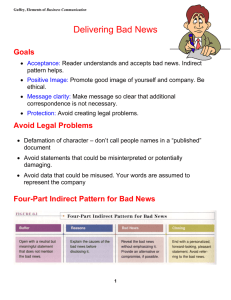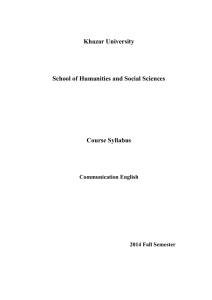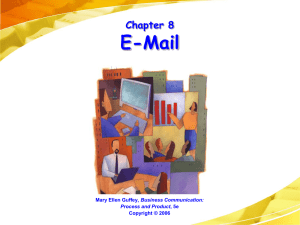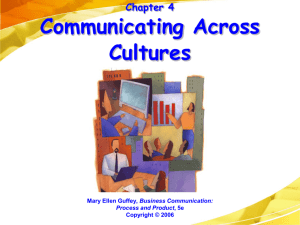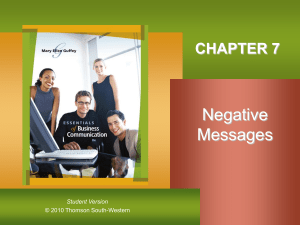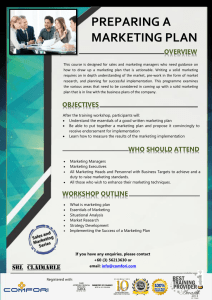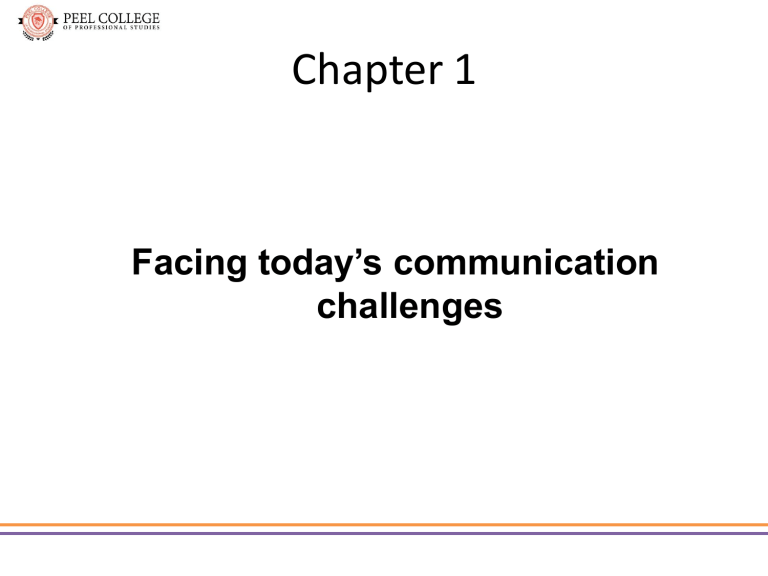
Chapter 1 Facing today’s communication challenges Communication Skills: Your ticket to work... OR Your ticket out the door! Mary Ellen Guffey, Essentials of Business Communication, 8e Chapter 1, Slide 2 Topics in the Chapter-1 ▪What is communication? ▪What is business communication? ▪Why Good communication skills are essential? ▪Succeeding in the changing world of work ▪Examining the Process of Communication ▪Nonverbal Communication ▪Culture and Communication & Dimensions of Culture ▪ Tips for minimizing written miscommunication among cross cultural audiences Mary Ellen Guffey, Essentials of Business Communication, 8e Chapter 1, Slide 3 What is Communication? In general, communication means exchange of ideas, message, information data etc. between two or more persons. Communication takes place orally, non-orally, symbolically or in writing. ▪ According to W.H. Newman and C. F. summer, Communication is an exchange of facts, ideas, opinions, or emotions by two or more persons. ▪ According to William Scott, Communication is a process which involves transmission and accurate replication of ideas ensured by feedback for the purpose of eliciting action which will accomplish organizational goals. Mary Ellen Guffey, Essentials of Business Communication, 8e Chapter 1, Slide 4 What is Business communication? ✓ When business related information is transferred from one person to another it is called business communication. ✓ Business communication may occur internally or externally. ✓ If business oriented events, thinking, thoughts and emotions or transactions are exchanged among businessmen it is referred to as business communication. Mary Ellen Guffey, Essentials of Business Communication, 8e Chapter 1, Slide 5 Good communication skills are essential for ▪ Job placement ▪ Job performance ▪ Career advancement ▪ Success in the new world of work Mary Ellen Guffey, Essentials of Business Communication, 8e Chapter 1, Slide 6 Succeeding in the changing world of work Information as a corporate asset New work environments Flattened management hierarchies More participatory management Trends in the new workplace Innovative communication technologies Increased emphasis on teams Heightened global competition Mary Ellen Guffey, Essentials of Business Communication, 8e Chapter 1, Slide 7 The Process of Communication Mary Ellen Guffey, Essentials of Business Communication, 8e Chapter 1, Slide 8 The Process of Communication How may the sender encode a message? Verbally or nonverbally. By speaking, writing, gesturing. What kinds of channels carry messages? Letters, e-mail, memos, TV, telephone, voice, body. Others. Mary Ellen Guffey, Essentials of Business Communication, 8e Chapter 1, Slide 9 The Process of Communication How does a receiver decode a message? Hearing, reading, observing When is communication successful? When a message is understood as the sender intended it to be. How can a Ask questions, check communicator reactions, don’t dominate provide for feedback? the exchange. Mary Ellen Guffey, Essentials of Business Communication, 8e Chapter 1, Slide 10 Nonverbal Communication Silent messages communicated by: ▪Eye contact ▪Facial expression ▪Posture and gesture ▪Time (punctuality and structure) ▪Space (arrangement of objects) ▪Territory (privacy zones) ▪ Appearance(Appearance of business documents, Appearance of people) Mary Ellen Guffey, Essentials of Business Communication, 8e Chapter 1, Slide 11 Culture and Communication Good communication demands special sensitivity and skills when communicators are from different cultures. © 2008 Image Source Black/Jupiter Images Mary Ellen Guffey, Essentials of Business Communication, 8e Chapter 1, Slide 12 Dimensions of Culture Context Time Orientation Individualism Culture Communication Style Mary Ellen Guffey, Essentials of Business Communication, 8e Formality Chapter 1, Slide 13 Dimensions of Culture Context High-context cultures (those in Japan, China, and Arab countries) tend to be relational, collectivist, and contemplative. Mary Ellen Guffey, Essentials of Business Communication, 8e Chapter 1, Slide 14 Dimensions of Culture Context Low-context cultures (those in North America, Scandinavia, and Germany) tend to be logical, linear, and actionoriented. Mary Ellen Guffey, Essentials of Business Communication, 8e Chapter 1, Slide 15 Dimensions of Culture Individualism ▪ High-context cultures tend to prefer group values, duties, and decisions. ▪ Low-context cultures tend to prefer individual initiative, self-assertion, and personal achievement. Mary Ellen Guffey, Essentials of Business Communication, 8e Chapter 1, Slide 16 Dimensions of Culture Formality ▪ North Americans place less emphasis on tradition, ceremony, and social rules. ▪ Other cultures prefer more formality. Mary Ellen Guffey, Essentials of Business Communication, 8e Chapter 1, Slide 17 Dimensions of Culture Communication Style High-context cultures rely on nonverbal cues and the total picture to communicate. Meanings are embedded at many socio-cultural levels. Mary Ellen Guffey, Essentials of Business Communication, 8e Chapter 1, Slide 18 Dimensions of Culture Communication Style Low-context cultures emphasize words, straightforwardness, and openness. People tend to be informal, impatient, and literal. Mary Ellen Guffey, Essentials of Business Communication, 8e Chapter 1, Slide 19 Dimensions of Culture Time Orientation ▪ Time is precious to North Americans. It correlates with productivity, efficiency, and money. ▪ In some cultures time is unlimited and never-ending, promoting a relaxed attitude. Mary Ellen Guffey, Essentials of Business Communication, 8e Chapter 1, Slide 20 Tips for minimizing written miscommunication among cross cultural audiences 1. Adopt local style: Use local formats and styles used in the intended reader’s country. 2.Consider hiring a translator: Engage a translator if • Document is important • Document will be distributed to many readers • To be persuasive 3.Use short Sentences and short paragraphs: sentences with fewer than 15 words and paragraphs with fewer than 5 lines are most readable. Mary Ellen Guffey, Essentials of Business Communication, 8e Chapter 1, Slide 21 Tips for minimizing written miscommunication among cross cultural audiences 4. Avoid ambiguous wording: ➢ Include relative pronouns (that , which, who) for clarity in introducing clauses ➢ Stay away from contractions (especially like Here’s the problem) ➢ Avoid idioms (once in a blue moon) ➢ Slang (my presentation really bombed) ➢ Acronyms (ASAP for as soon as possible) ➢ Abbreviations ➢ Jargon (input, output, bottom line) ➢Use action specific verbs(purchase a printer rather than get a printer) Mary Ellen Guffey, Essentials of Business Communication, 8e Chapter 1, Slide 22 Tips for minimizing written miscommunication among cross cultural audiences • 5. Cite Numbers Carefully ➢Use figures(15) instead of spelling them out (fifteen) ➢Always convert dollar figures into local currency ➢ Avoid using the figures to express the month of the year. (In North America June 17, 2013 is written as 6/17/13 while in Europe 17.6.13) Mary Ellen Guffey, Essentials of Business Communication, 8e Chapter 1, Slide 23

